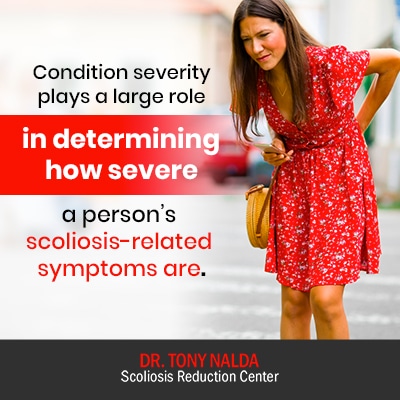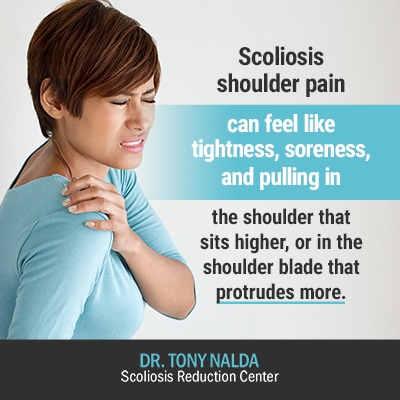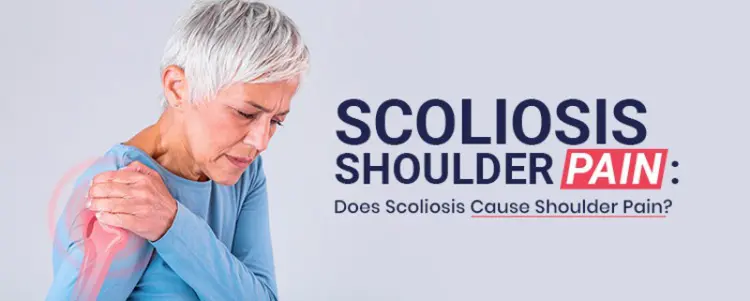As a progressive spinal condition, having scoliosis means having a spine that curves abnormally to the side and rotates. As a person develops scoliosis, a lot of uneven forces are being introduced to the body. Keep reading to learn about some of the symptoms, including shoulder pain, that scoliosis can cause.
Scoliosis is a highly-variable condition, meaning it can range between mild, moderate, severe, and very severe. Particularly, when a person’s scoliosis is located in the upper spine, the uneven forces it introduces can be felt by the upper body and cause scoliosis shoulder pain.
Scoliosis is a complex condition, known to produce a wide range of symptoms. As every case is different due to a number of important patient and condition characteristics, let’s discuss the most important variables that contribute to experienced symptoms.
Important Condition Features
As mentioned, scoliosis is highly variable, meaning each case is as unique as the patient themselves. This is why treatment plans need to be customized for each specific patient and their condition.
Part of that customization depends on the type of scoliosis a person develops, so let’s touch on the different forms of scoliosis that can develop.
Condition Form
The vast majority of known diagnosed scoliosis cases are idiopathic, meaning there is no single known cause. Adolescent idiopathic scoliosis (AIS), diagnosed between the ages of 10 and 18, accounts for 80 percent of diagnosed cases.
The other 20 percent are condition forms with known causes such as neuromuscular, congenital, degenerative, and traumatic.
When it’s a common form, such as AIS, the scoliosis can be treated effectively by working towards a curvature reduction and increasing core strength to better support and stabilize the spine. When it’s an atypical form, such as neuromuscular, the underlying neuromuscular disease causing the scoliosis has to be addressed and becomes the guiding force of treatment.
Just as different treatment approaches produce different outcomes, different condition forms can produce different symptoms and severity levels.
So condition form, and cause, is a defining condition characteristic; another is condition severity.
Condition Severity
Condition severity is determined by the results of a patient’s scoliosis X-ray. A measurement known as ‘Cobb angle’ is taken by drawing lines from the bottoms and tops of the most-tilted vertebrae (bones of the spine) in the curvature. The intersecting lines form an angle, and this angle places the condition on its severity scale.
The higher the Cobb angle, the more misaligned the spine is and severe the condition is, and generally speaking, the more noticeable symptoms it will produce.
- Mild scoliosis: Cobb angle measurement between 10 and 25 degrees
- Moderate scoliosis: Cobb angle measurement between 25 and 40 degrees
- Severe scoliosis: Cobb angle measurement of 40+ degrees
- Very-severe scoliosis: Cobb angle measurement of 80+ degrees

Condition severity plays a large role in determining how severe a person’s scoliosis-related symptoms are.
An important patient characteristic that contributes to whether or not a condition is painful is age.
Patient Age
When it comes to scoliosis-related pain, age is a big determining factor in how painful people find their condition. This is due to growth and skeletal maturity.
With AIS, the condition’s most common form, it is rarely painful. While an abnormally-curved spine might sound like it would always be painful, that’s not the case.
With children and adolescents who are still growing, their spines are constantly experiencing a lengthening motion as the spine grows along with the rest of the body.
Now, when a spine is abnormally curved and rotates, pressure and compression is felt by the spine and its surroundings: muscles, vessels, and nerves.
The lengthening motion of a growing spine counteracts the compressive force of the curvature, which is the cause of pain; in adults who are no longer growing, there is nothing to counteract the compression, which is why adults generally experience pain as part of life with the condition, especially if left untreated and/or degenerative effects of aging come into play.
So when it comes to pain-related symptoms of scoliosis, age plays a large role in determining whether a person is likely to find their condition painful or not.
Curvature Location
There are three main sections of the spine, and scoliosis can develop along any of them: lumbar (lower back), thoracic (middle and upper back), and cervical (neck).
When an abnormal curvature develops, this means there is a loss of the spine’s healthy curves, as the body responds by putting in counteracting curves; this affects the biomechanics of the entire spine, and not just where the most-tilted vertebrae are located.
While developing symptoms also depend on other factors such as form, age, and condition severity, in many cases, curvature location can also play a role, especially in terms of pain and discomfort caused by nerve compression and sore muscles located closest to the site of the curvature’s most-tilted vertebrae.
While every case is different based on the above features, there are some common scoliosis symptoms related to the asymmetrical affect that scoliosis has on the body in terms of postural changes.
In the condition’s most common form (AIS), signs of scoliosis are mainly related to posture and are located in the back, hips, shoulders, and shoulder blades.
Scoliosis Shoulder Pain
When a body and spine is aligned (straight), the shoulders will sit level with one another and are front-facing. When there is a structural issue that causes uneven shoulders, such as scoliosis, one shoulder can sit higher than the other and/or one shoulder blade can protrude more on one side than the other.
If shoulders become uneven, it can lead to neck, shoulder, shoulder blade, and lower back pain, and this is especially the case when there are other imbalances present in the body, which scoliosis is known to cause.

Scoliosis shoulder pain can feel like tightness, soreness, and pulling in the shoulder that sits higher or in the shoulder blade that protrudes more. In addition, shoulders can become more rounded forward in appearance.
Some people with scoliosis describe scoliosis shoulder pain as feeling like there is always a knot in their shoulder.
When a person with scoliosis is experiencing significant shoulder pain, it’s commonly related to curvature location. If a person’s spine is abnormally curved in the upper back, near the top of the spine, this means the muscles in that same section are having to work harder to support and stabilize the spine.
This extra work strains the muscles and commonly produces aches and pains in the shoulders and produces scoliosis shoulder blade pain.
Severity of Scoliosis Shoulder Pain
As mentioned earlier, it’s hard to say how severe scoliosis shoulder pain can be because every case is different. Even two people with the same Cobb angle can experience different symptoms and different pain levels.
In some cases, scoliosis shoulder pain and scoliosis shoulder blade pain is described as a mild dull ache or uncomfortable tightness, and in other cases, the pain can be severe.
The same can be said of scoliosis back pain: every patient is different as the severity of experienced symptoms depends on a number of variables.
Treatment for Scoliosis Shoulder Pain
When it comes to treatment for scoliosis shoulder pain, here at the Scoliosis Reduction Center®, we prioritize addressing and treating the underlying cause of related scoliosis symptoms, not just the symptoms themselves.
Too often, in general medicine, pain medications are dolled out because this is the easiest course of treatment both for the doctor and the patient. It does make sense, in one regard: a patient is in pain, so give them pain medication to ease their discomfort.
The problem I have with this approach is that it’s not addressing the underlying cause of the pain. In addition, especially in the context of progressive conditions, pain medications can cause potential harm by masking increasing symptoms and progression (condition getting worse).
Here at the Center, we get to the root cause of experienced symptoms, such as scoliosis shoulder pain, by treating the condition causing it: the scoliosis itself.
In order to do that, we customize a treatment plan using a chiropractic-centered approach that prioritizes function and correction. As we work towards reducing the abnormal curvature and restoring as much of the spine’s natural and healthy curves as possible, on a structural level, we are also addressing the uneven forces that cause symptoms like postural changes and pain.
By fully customizing our treatment plans, we are also addressing the specifics of each individual condition including form, condition severity, age, and curvature location.
We use an integrative approach that combines multiple scoliosis-specific treatment disciplines such as chiropractic care, in-office therapy, custom-prescribed home exercises, and specialized corrective bracing.
As we work towards reducing a patient’s curvature on a structural level, we are also adding scoliosis-specific stretches and exercises that help ease the tightness experienced by strained muscles, as well as strengthening them so they are better able to support and stabilize the scoliotic spine.
Conclusion
So to clearly answer the question, does scoliosis cause shoulder pain: yes, it can. However, it is not necessarily going to be a part of everyone’s experience of life with the scoliosis. Depending on the individual characteristics of a patient and their condition, shoulder pain may or may not be an issue.
As scoliosis is not known to cause pain in children and adolescents, the condition’s main form (AIS) is less likely to cause scoliosis shoulder pain than in adults living with scoliosis.
In addition, curvatures that are located in the upper back are more likely to produce the symptom of shoulder pain; it’s the muscles located closest to the curvature that have to work the hardest to compensate for the curvature, becoming strained and tight as a result.
Uneven shoulders is one of the telltale signs of scoliosis as the abnormal spinal curvature can cause postural changes that range from mild to very severe.
Here at the Scoliosis Reduction Center®, we address shoulder pain by treating its underlying cause: the scoliosis itself.
Through a chiropractic-centered functional approach, we can reduce curvatures, improve the spine’s biomechanics, and reduce/remove the adverse pressure causing postural changes and symptoms, such as uneven shoulders and pain.





